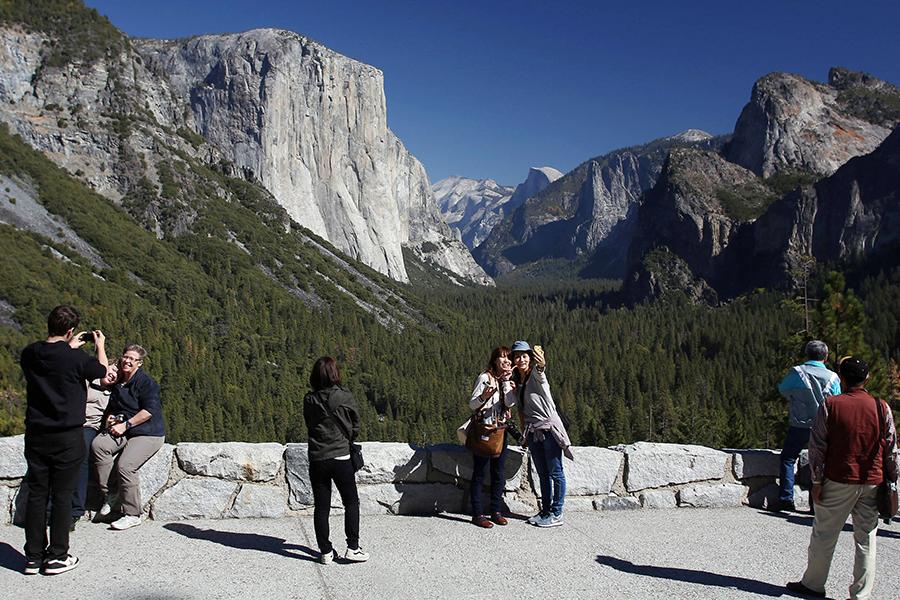Will heat make Yosemite's iconic arches and cliffs fall apart?
Yosemite National Park’s most iconic sites – the cliffs of El Capitan and Half Dome and the boulders dotting the floor of Yosemite Valley – all owe their structures to thousands of years of rockfalls.
But the tumbling rocks that have shaped California’s rock-climbing mecca are also unpredictable and dangerous to the 4 million people who visit the park every year.
This is why geologists have been trying to understand the forces that cause Yosemite’s granite cliffs to fracture and shed massive boulders that can hurtle 1,000 feet to the ground, leveling everything in their paths. They know that tectonic stresses and erosion cause granite rock to fracture. Then, when rainwater collects in the cracks, it decomposes the rock over time, or freezes in the cracks, ultimately breaking apart the rock. Vegetation also can grow in the cracks and pry apart the granite.
But geologists have been stumped by the mysterious forces that trigger rockfalls during times of no rain, earthquakes, or freezing. More than half of the documented rockfalls in the park cannot be explained.
Recently, scientists confirmed an additional culprit: high temperatures.
In a March 28 study in Nature Geoscience, the US Geological Survey (USGS) and the National Park Service (NPS) conclude that hot days can cause rock to fall.
Heat appears to have caused 15 percent of all mysterious rockfalls in Yosemite, during the hottest hours of the day in the hottest months, July through September.
“All of a sudden we can say, ‘Well, maybe the thermal stress factor had something to do with it,’” Brian Collins, a USGS geotechnical engineer and co-author of the paper, told the Los Angeles Times.
He and his colleague Greg Stock, a Yosemite park geologist, monitored Royal Arches, a cliff that rises above Yosemite Valley, for three-and-a-half years. They were particularly interested in a 19-meter-tall, 4-meter-wide, and 10-centimeter-thick sheet of rock that formed in a process called “exfoliation,” which starts with a fracture that develops parallel to the surface of the slope and causes a large slab of rock to peel, and ultimately fall off.
Dr. Collins and Dr. Stock climbed up to the flaking rock and installed sensors behind it to measure how much it moves throughout the day, as the Times reported.
The scientists found that daily heating and cooling of the rock surface stressed it by causing the crack to open and close by nearly half an inch in this process of exfoliation, which formed Royal Arches and the face of Half Dome, says the NPS online.
“We look around the landscape and we see thousands and thousands of these flakes and we have to assume they’re all moving,” Collins told the Times.
Rocks have been moving and falling in Yosemite since the glaciers there receded some 15,000 to 19,000 years ago. Documented rockfalls date back to 1857. According to an NPS inventory, 925 rockfalls and landslides were reported in the 154 years between 1857 and 2011, and many more were undoubtedly either unreported or just not noticed.
Rockfalls have damaged roads, trails, and other facilities, and have killed 15 people and injured at least 85 others. The NPS calls them “the most powerful geologic agent acting today in Yosemite.”
Predicting rockfalls is nearly impossible – it's like predicting earthquakes – but scientists are trying. The more they learn, the more their findings can help planners around the world better assess the risks of allowing people to live or camp near susceptible rock formations.
“Rockfalls induced by temperature fluctuations should be considered in rockfall hazard assessments – and not just for the famous granitic cliffs of Yosemite, but for inhabited mountain regions throughout the world," wrote Valentin S. Gischig, a geologist at the Swiss Competence Center for Energy Research, in a commentary with the study.
"Possibly, as the climate warms in the coming decades, thermally induced rockfalls may become even more important to hazard assessment and cliff erosion,” he wrote.






